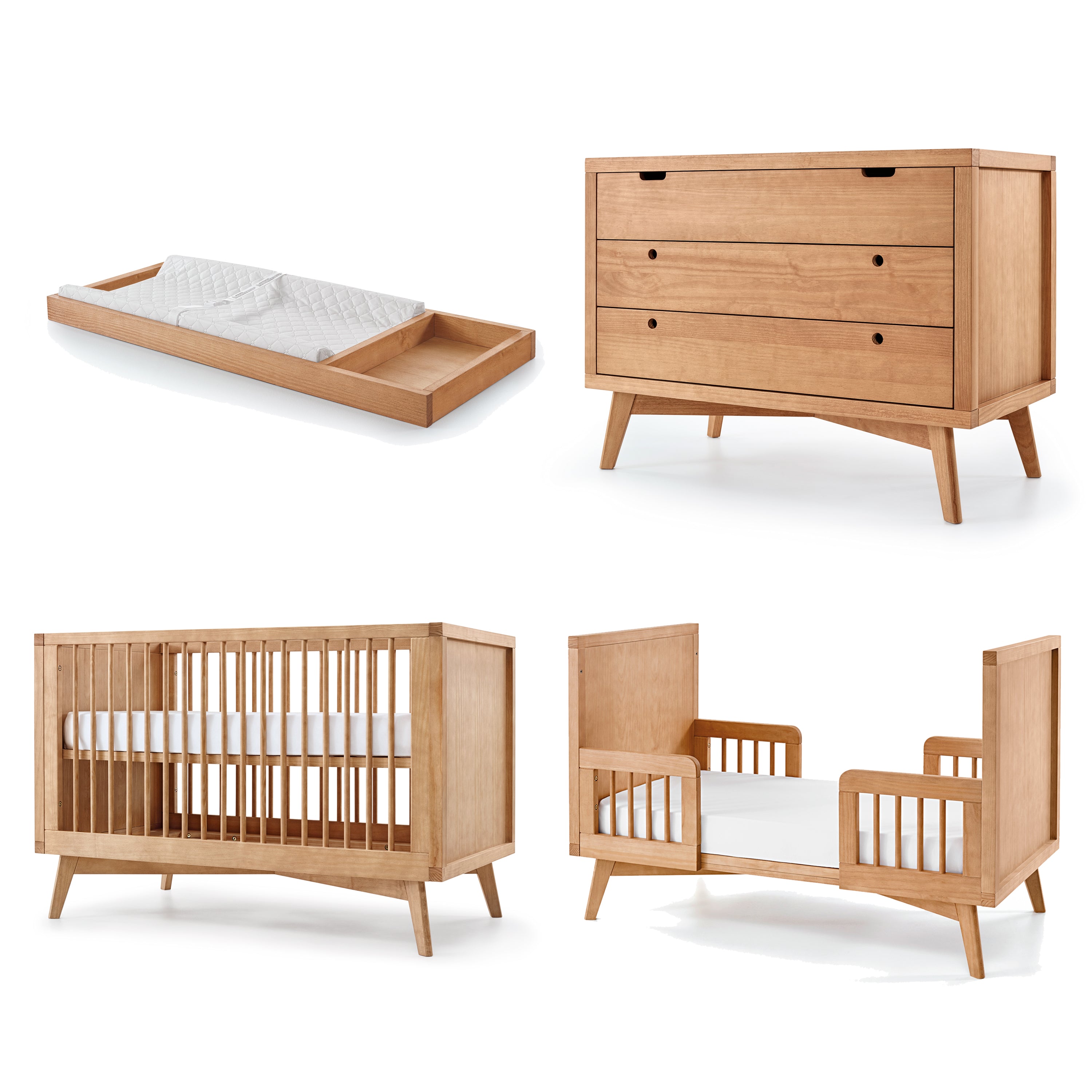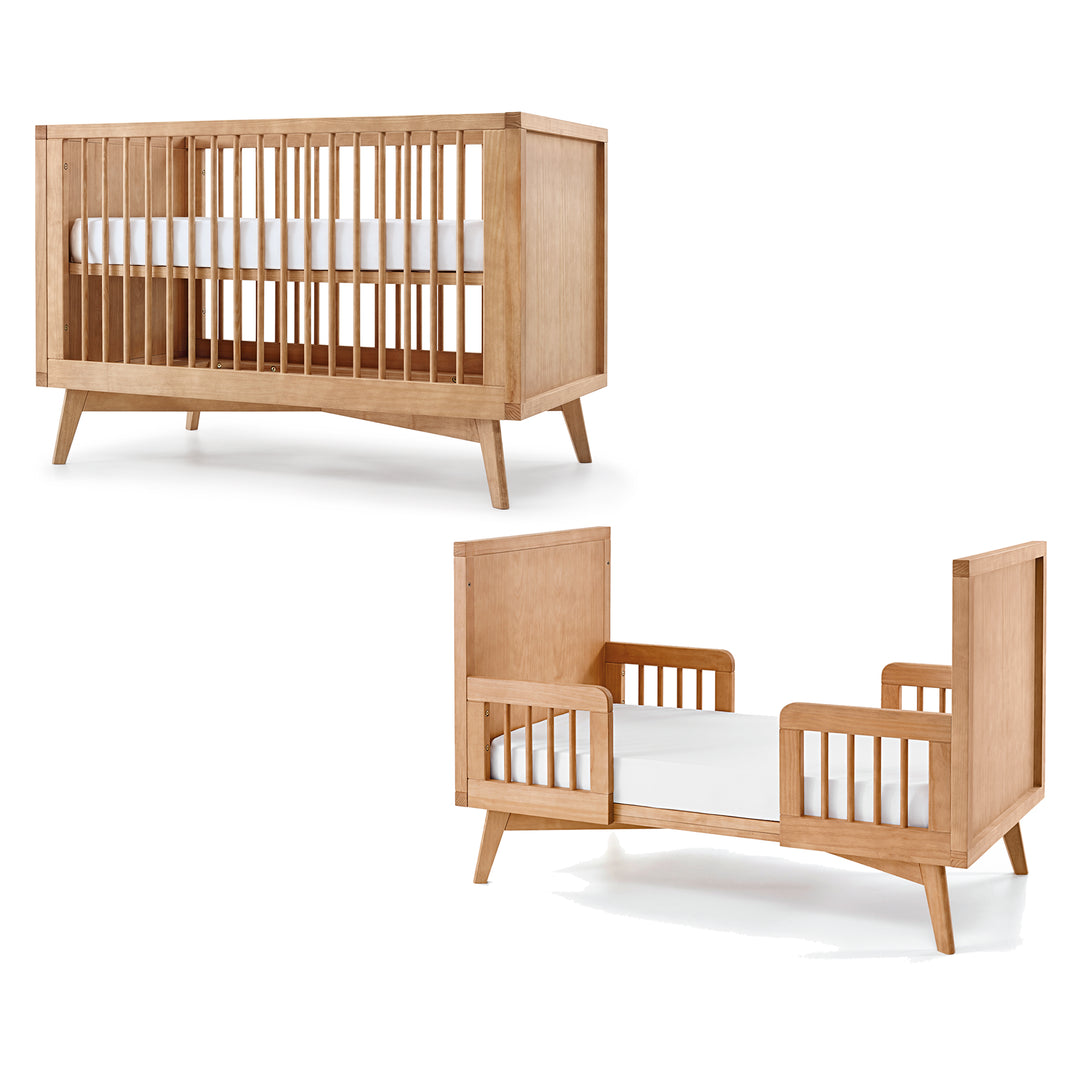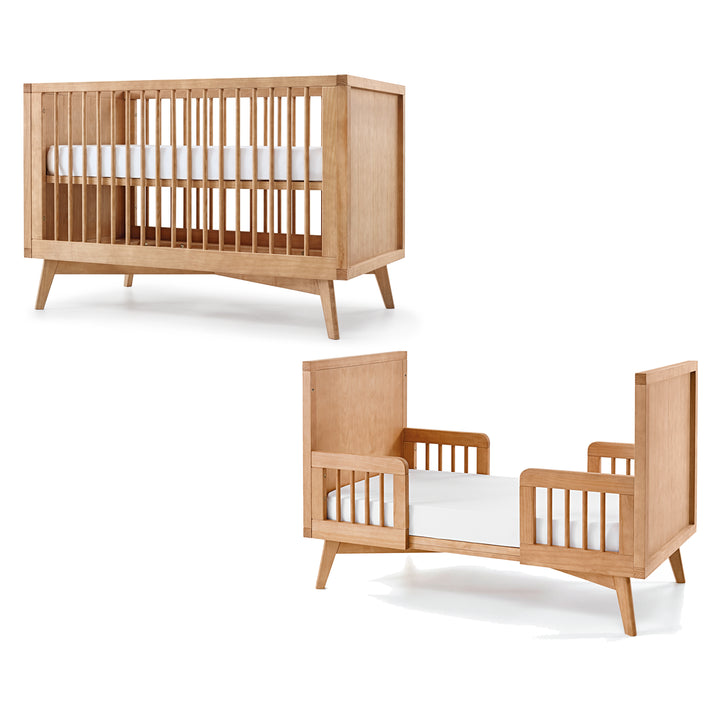Lighting in Your Baby’s Nursery: How to Set Up Lighting Without Disturbing Your Little One’s Sleep!
When we become moms, the thought of our baby sleeping during the day instead of at night becomes a great fear. So, how can you prepare an environment that supports your baby’s sleep?
A nursery room is a special place where each detail is carefully planned to ensure comfort and safety.
Therefore, lighting plays a crucial role in the room: it not only creates a cozy atmosphere, but lighting also helps with day-to-day baby care activities and is very important for your baby’s peaceful sleep. In this article, I will share with you the best tips—as an architect and also a mom – to use lighting assertively!

In this project from our architect mom Thais we can see indirect light with a sconce and a lighting wall panel, highlighting our Samba Convertible Crib in Hazelnut – Spindles creating different lighting options for the room
When we become moms, the thought of our baby sleeping during the day instead of at night becomes a great fear. But how can we prepare an environment that supports our baby’s sleep and is safe enough to assist our baby in an eventual diaper change or even during breastfeeding?
Some details are very important: sleep hygiene, routine… And the nursery room, too! A good night’s sleep starts during the day, with natural daylight exposure in the correct amount – from sunrise to sunset – and dimming artificial lights when daylight is over. Gentle lighting in the evening is crucial to provide a comforting environment, inhibiting the baby’s natural melatonin production in the body (melatonin is a hormone produced by the body that enhances the start of a good night’s sleep and keeps the body asleep). At the same time, we need lighting for diaper changes, breastfeeding…, and assisting our babies whenever necessary.
That’s why I always suggest that there must be two lighting scenarios: one main light and another support lighting.
Main Lighting
For the nursery’s main lighting, I suggest diffuse lighting that illuminates the room equally – no glaring for the baby’s eyes. Remember: your baby is laying down on the crib facing upwards, therefore spot lights or other illumination directed downwards can disturb their developing vision. You can install LED strip lights inside a cove or illumination directed to the ceiling. Choosing dimmable lighting is also great for creating different scenarios, from a brighter light for daytime activities to a softer light for relaxing moments in the evening.

In this nursery project also from Thais we see indirect light on the panel, a lampshade for ambiance and our Retro Crib, Dresser and Changing Tray Nursery Set in Natural Washed
Support Lighting
Smaller lighting spots such as lampshades or sconces are useful to create a comforting atmosphere during breastfeeding, diaper changes, and even reading story books before sleep (when the baby has grown). Make sure the lighting is gentle so that it’s not harsh for the eyes, and simultaneously, you need to be able to easily turn it on or off – from your breastfeeding armchair or a Montessori bed, for example. There are also white noise devices with gentle lighting integrated into them. I have one, and I think it’s fantastic!
You can use bollards, too—these are sconces installed next to the floor, up to 15 inches high. They stay away from your field of vision and can make walking around the room so much easier. Besides these, there are some luminaires that are integrated to connect straight to the outlet or as sockets for light bulbs. They can be plugged into your lower outlets and work as bollards, too.

A lampshade in warm light for breastfeeding or a bedtime story and our Retro Side Table in Natural Washed
Light Temperature? Brightness?
Light temperature is very important! For home ambiance, I always suggest that the lighting temperature should be between 2800K – 3000K (warm light). Yet, while diaper changing or breastfeeding, I suggest red or yellowish lights – there are special spot lights ready to plug into your outlet, such as the ones I have described when talking about indirect lighting, which works very well with red light bulbs. The red light is the most favorable for the sleep cycles – not only for the babies but also for ours! Other colors can disturb your baby’s sleep and make your baby more awake – especially blue and white lights.
As a matter of fact, there are many studies that correlate 6000k blue artificial lights (aka white lights) to eye problems.
About brightness: you need to know the brightness of the light emitted by the light bulb that you have chosen for your nursery to check if the light is adequate – temperature does not interfere here. You can usually find this info on the product’s box, and it’s indicated by lumens (lm) or watts (W). In a lighting project, we calculate with other types of information such as wall colors, natural light, etc). However, to make it easier, I suggest you add the lumen from all the light bulbs and divide it by the room’s square footage. The aftermath should be around 150-200lux – which is the ideal illuminance expected for a bedroom.
For example, you have a ceiling light with two light bulbs and want to know if this is enough to light a 107-square-foot room. As the illuminance measurement needs to be done in square meters, it is necessary to transform the dimensions: if 1 square foot = 0,093 square meters, 107sf x 0,093 = 9,95m². Each lamp has 7W of brightness and 560 lumens of luminous flux, so 2 (two light bulbs) x 560 (a light bulb’s luminous flux) = 1020. So 1020/9,95 (room’s square meters) = 102,5lux. As a result, the light isn’t enough, so I suggest changing the ceiling light or adding another source of light, such as a lampshade, a sconce, or light spots.
What about the external light?
Now that we have prepared all the lighting from the inside, what about the light source that comes from the poles from the street? A blackout curtain is essential to block the outer light during naps and night sleep (during the day, the baby should sleep in the dark – it may even be very low light, but it shouldn’t be bright!). This light blockage can be made with blackout curtains, external blinds, or even aluminum foil attached to the windows. Besides blackout curtains, don’t forget to cover all possible LEDs/infrared lights from appliances such as baby monitors or air conditioners.

Curtains can make your nursery more intimate and cozier for your little one. Check out our Retro Crib and Conversion Kit Nursery Set in Hazelnut
When planning your nursery’s lighting, remember to always prioritize safety, comfort, and functionality.
With a careful choice of gentle and dim lighting, you can create a sleep-friendly environment that will greatly benefit your baby’s sleep and also be cozy enough for those who care for them.
A warm hug full of love from Luli’s mamma 😊

Thais Silva has been a practicing architect for over 6 years. In 2023, she became a mother and can now add more knowledge, empathy and tenderness in each of her projects of nurseries and kids’ rooms.




































































Leave a comment